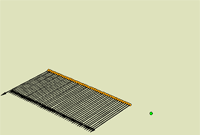Common project IPCMS (Strasbourg)
"Magnetism of transition
metal's surfaces and interfaces"
Summary
The project CNRS-RAS 1995-1997 was aimed to investigate the electronic
structure of low -dimesional magnetic systems such as metallic surfaces,
thin overlayers, films and superlattices.
Theoretical description of these systems was performed within the
framework of model Hamiltonian approach. It includes self-consistent
calculations of magnetic moments by real space recursion method
in mean field approximation.
Such approaches based on Hubbard (HM) and Periodic Anderson Models
(PAM) were developed and the influence of space defects - steps
at the surface and interface, roughness and embedded clusters near
interfaces, pinhole defects - on the magnetic structure of Low Dimensional
Magnetic Systems (LDMS) was investigated.
The main results, which were obtained within the given project,
are the following:
The theory for self-consistent determination of magnetic structure
of spatially non-homogeneous systems is developed. Calculations
of magnetic moments distribution of stepped Fe(Cr) surfaces and
Cr(Fe) monolayers on these surfaces within HM and PAM shows that
the main qualitative features of these distributions coincide
for both models. It clarified the potentiality of the methods
and the possibility of describing real experiments of FeCr low
dimensional systems by these methods. Calculations performed allow
rationalization of the apparently contradictory observations obtained
by spin-resolved and angle-and-energy resolved photoemission.
The distribution of magnetic moments in Fe/Cr/Fe sandwiches with
pinhole defects has been studied using PAM. Self-consistent calculations
were performed in the Hartree-Fock approximation for ideal smooth
and rough interfaces generated by special algorithm. It was shown
that for a sandwich structure of Fe antiferromagnetically coupled
across a Cr spacer the pinhole defects induce a non-zero magnetization
at zero external magnetic field. Fe atoms inside pinholes show
different magnetic moments in dependence of the number of Fe atoms
among its nearest neighbors. The role of interface roughness and
pinhole defects on the stability of magnetic states has been investigated
through total-energy calculations.
A new method based on PAM for calculation of noncollinear magnetic
ordering in 3d-systems is developed. Iteration process includes
self-consistent determination of population numbers for the electrons
with different direction of the magnetic moments at given atom
relatively to the fixed axis. Analytical transformation based
on the generalized "zeros and poles" methods was performed
for the Green functions. It allows avoiding some time consuming
numerical procedures and gives the possibility to develop efficient
algorithm for the calculation of noncollinear magnetic structures
of complex space non-homogeneous systems. Calculations performed
for the parameters corresponding to Fe and Cr show qualitatively
different dependencies of the magnetic moment magnitude and the
energies of d-electrons on the angles, which define the direction
of magnetic moments.
Magnetic structure of nonideal Fe/Cr interface was investigated
within the framework of PAM. The distribution of magnetic moments
obtained for two sets of interfaces (with different roughnesses)
shows strong sensitivity of the magnetic structure on the interface
roughness and interdiffusion. Application of the theory for interpretation
of Mossbauer spectra of Fe/Cr superlattices was suggested.
In experimental field a set of superlattices 57Fe/Cr
with different thicknesses on Cr spacer were grown by using Molecular-Beam
Epitaxy method. Investigations by means of Conversion Electron Mossbauer
Spectroscopy allow to obtain important information about the distribution
of hyperfine fields. This experiment gives some insight to the determination
of the magnitude as well as directions of magnetic moments. Polarized
neutron investigations performed at ILL (Grenoble, France) show
a good quality of the superlattices structure.
Publications
- C.Demangeat and V.M. Uzdin. Hubbard and Anderson periodic models
for description of imperfect low-dimesional FeCr magnetic systems.
J. Magn. Magn. Mater. 156 (1996) 202.
- V.M. Uzdin and C Demangeat. Pinhole defects in Fe/Cr trilayers.
J. Magn. Magn. Mater. 165 (1997) 458.
- V.M. Uzdin, N.S Yartseva. Periodic Anderson Model for the discription
of noncollinear magnetic structure in low-dimensional 3d-systems.
Comp. Mat. Sci. 10 (1998) 211.
- N.S. Yartseva, V.M. Uzdin, C. Demangeat. Magnetic structure
of nonideal Fe/Cr interface, Comp. Mat. Sci. 10 (1998)
255.
Abstracts
- N.S. Yartseva, V.M. Uzdin, and C. Demangeat. Magnetic structure
of defects at the Fe/Cr interface. Role of noncollinearity. -
Book of Abstracts of ICAM/E-MRS'97, Strasbourg (France), 16-20
June 1997, D-36.
- V.M. Uzdin and N.S. Yartseva. Periodic Anderson Model for the
description of noncollinear magnetic structure in low-dimensional
3d-systems.- Book of Abstracts of ICAM/E-MRS'97, Strasbourg (France),
16-20 June 1997, D-13.
|

